象山港大黄鱼Pseudosciaena crocea网箱养殖区沉积物-水界面营养盐通量研究
2016-04-23廖红芳郑忠明REGANNicholaus朱津永
廖红芳,郑忠明,REGAN Nicholaus,朱津永
(1.宁波大学 海洋学院,浙江 宁波 315211; 2.临武一中, 湖南 郴州 424300; 3. 浙江海洋高效健康养殖协同
创新中心,浙江 宁波 315211)
象山港大黄鱼Pseudosciaenacrocea网箱养殖区沉积物-水界面营养盐通量研究
廖红芳1,2,3,郑忠明*1,3,REGAN Nicholaus1,3,朱津永1,3
(1.宁波大学 海洋学院,浙江 宁波 315211; 2.临武一中, 湖南 郴州 424300; 3. 浙江海洋高效健康养殖协同
创新中心,浙江 宁波 315211)
摘要:2013年5月、8月和11月调查了象山港大黄鱼网箱养殖区及附近沉积物中总有机氮(TON)、总有机碳(TOC)和总磷(TP)含量,并采用实验室模拟法研究了底泥耗氧率(SOCs)和沉积物-水界面营养盐和)通量。结果表明:养殖区(YZ)沉积物中的TON和TP含量显著高于距离养殖区50 m(F1)和100 m(F2)的区域(P<0.05)。底泥释放到上覆水中,但是从上覆水中吸收和。沉积物-水界面营养盐通量表现出明显的季节性变化,在8月,及的释放量达到最大值。上覆水中和的质量浓度随着沉积物-水界面营养盐通量的变化而变化。研究表明,象山港大黄鱼养殖活动对养殖区底泥造成了一定污染,且通过影响沉积物-水界面营养盐通量影响上覆水中营养盐分布,最终给整个养殖系统造成生态负担。
关键词:养殖;大黄鱼;底泥;营养盐通量;象山港
0引言
网箱养殖在过去20 a迅速发展,是全球水产养殖业中增长最快的产业之一。然而在其迅速扩增的同时,对周边环境也造成了一定的困扰。网箱养殖对周边环境的影响主要是产生残饵、排泄物等有机废物[1-2],它们绝大部分以颗粒态形式沉积到底泥中,使沉积物质量迅速恶化[3]。积累到底泥中的有机物经过一系列的生物地球化学作用,最终以氮、磷等可溶性营养盐形式释放到水中,可能造成水体富营养化[4]。被污染的沉积物成为潜在污染源,反过来影响整个水产养殖系统甚至还会威胁野生生物和人类的健康[5-6]。近几年,越来越多的人关注网箱养殖对沉积环境造成的影响[7-8]。养殖对沉积环境的影响与渔场地点、养殖种类、投喂饲料、养殖规模及周围生物区系对固体废弃物的吸收能力等有关[9-10]。
大黄鱼是重要的经济鱼类,在我国广泛养殖。象山港内湾西泸港是大黄鱼的主要养殖基地之一,总面积约52 km2,水深为10~20 m。象山西泸港口小港大,其颈门最窄处宽仅为1 km左右,水体交换能力弱。近几年网箱数量成倍增长,养殖区域环境问题日益凸显,养殖活动对周围环境造成的影响逐渐引起人们的关注[11-12]。但是目前关于大黄鱼网箱养殖对沉积环境的影响了解较少。本文通过测定沉积层中氮、磷等有机物含量及沉积物-水界面营养盐通量,调查大黄鱼网箱养殖对沉积环境及整个水域生态系统的影响,以期对水产养殖业可持续发展战略制定及整个海岸区域的管理提供科学支持。
1方法
1.1研究地点及样品采集
分别于2013年5月、8月和11月在象山西泸港生态养殖基地大黄鱼养殖区 (29°32′0.16″N,121°45′4.09″E)采集样品。有3个采样点:大黄鱼养殖区(YZ)、距离大黄鱼网箱养殖区50 m(F1)及100 m(F2)区域(图1),每个地点随机采3个样品。
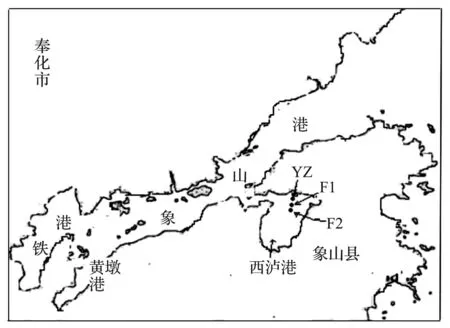
图1 采样站点示意图Fig.1 Sketch map of sample sites
用无扰动沉积物采样器[13]采集沉积物。迅速将采集的样品用沉积物转移装置(图2)转移至直径与采样管一样的培养管中,使培养管中的泥深为20 cm左右,注意避免沉积物扰动。培养管底部用塑料薄膜密封,顶端盖上橡胶盖。立即将采好的泥样避光冷冻保存,以抑制底栖生物和微生物活动,从而降低生物影响。用采水器采集水样。用YSI Proplus 型多参数测量仪现场测定水温及水中溶解氧。样品采好后在1 h内带回实验室。
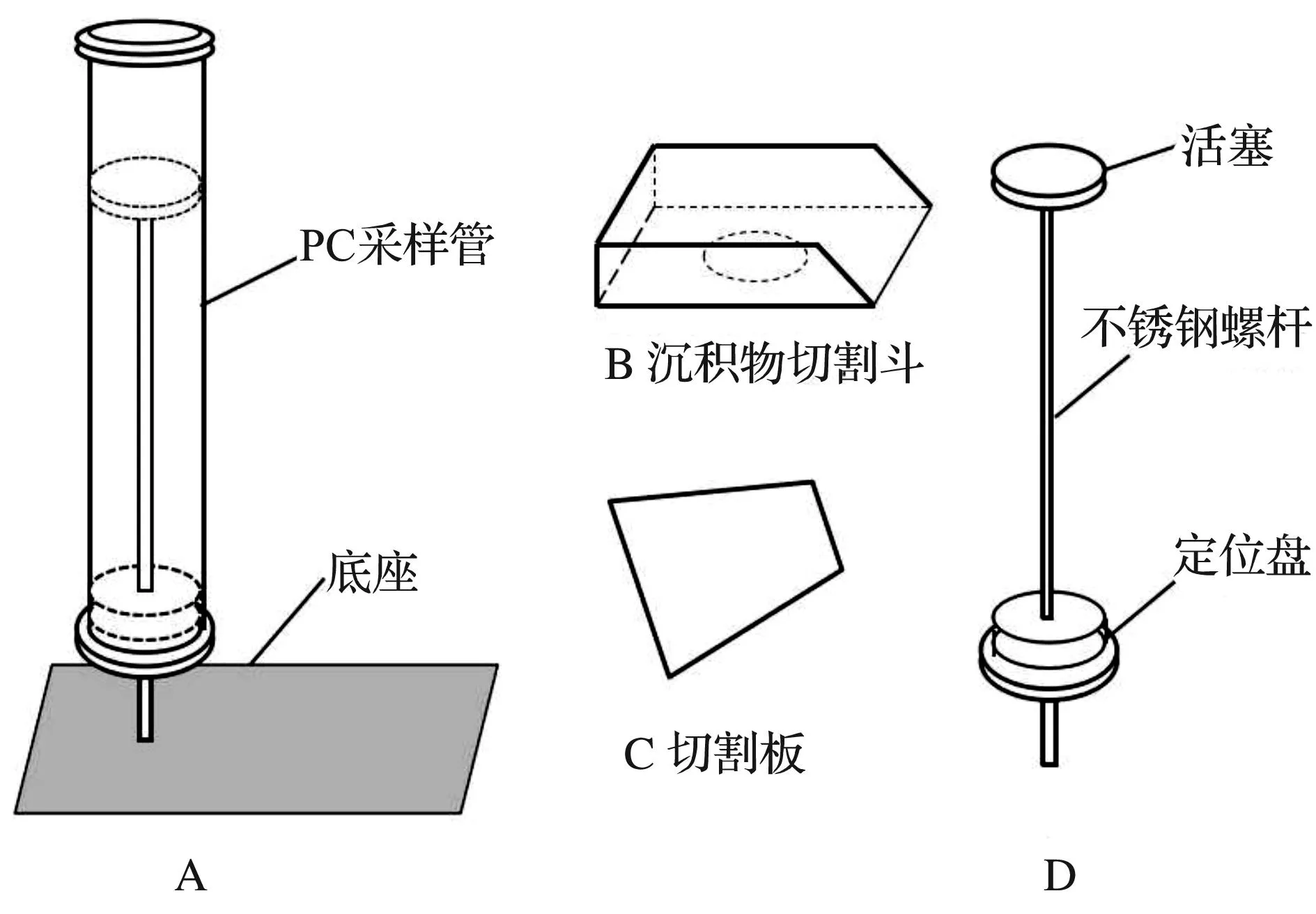
图2 沉积物转移装置示意图Fig.2 Sketch map of sediment transfer device
1.2实验室模拟实验

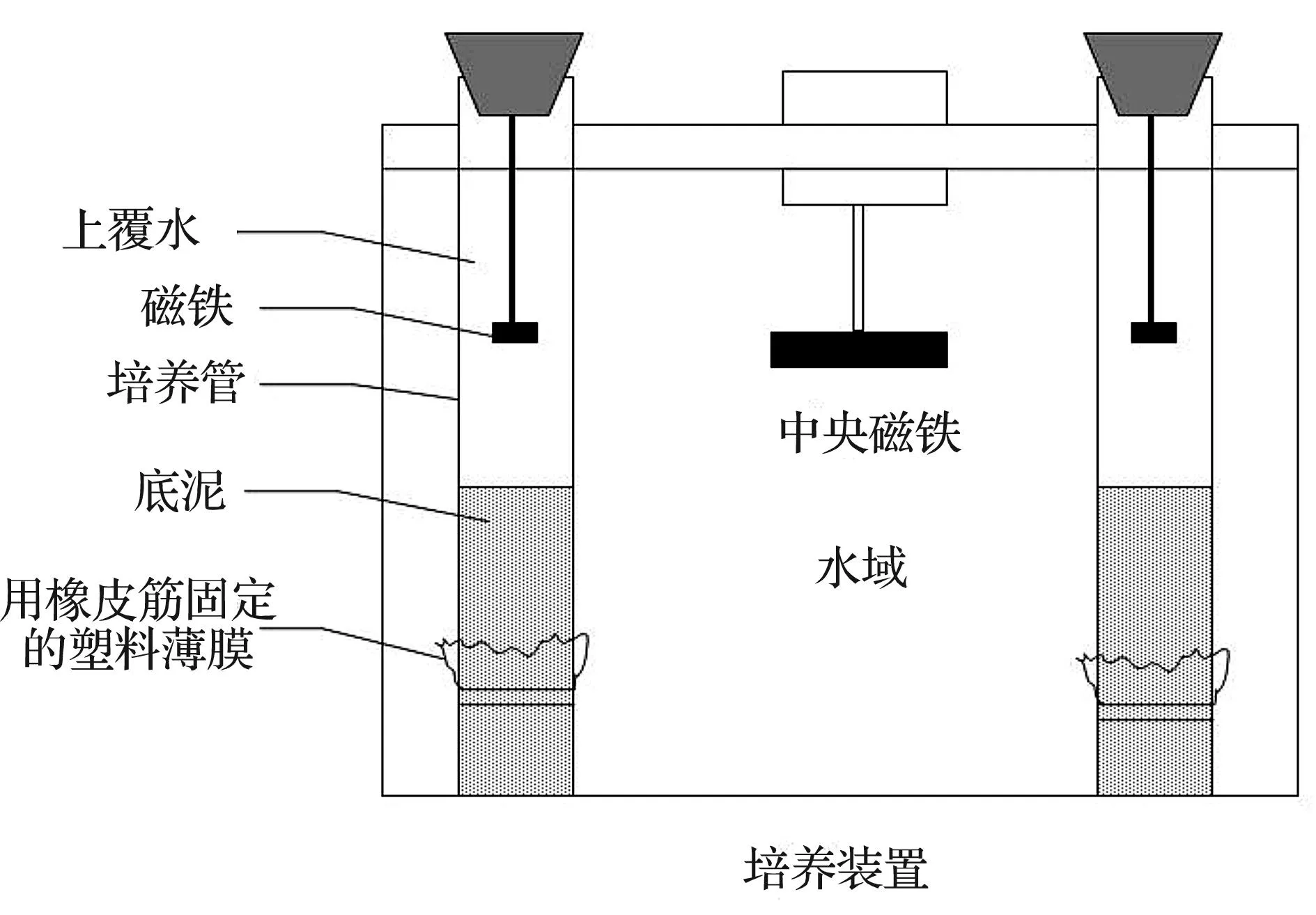
图3 沉积物培养装置示意图Fig.3 Sketch map of benthic chamber specially designedand built for the present study
1.3参数测定及分析方法

(1)
式中:F表示营养盐通量或底泥耗氧率;ΔC表示培养前后营养盐或氧质量浓度的变化(同时用空白对照校正);V表示培养管中上覆水的体积;A表示培养管底部的横截面积;t表示培养时间。F为正则表示沉积物向水中释放出营养物质,为负则表示营养盐进入沉积物中。
用元素分析仪 vario EL cube测定沉积物中总有机氮(TON)、总有机碳(TOC)及硫化物的含量;TON和TOC测定之前采用气相法酸化,将沉积物放入盛有浓盐酸的干燥器中过夜,然后在烘箱(60 ℃)中烘干,除去过量的盐酸。参照MUDROCH et al[15]的方法测定沉积物中的总磷(TP)。 采用烧失重法测定沉积物中有机物(OM)含量,称取一定量湿沉积物,在105 ℃下烘4 h,将烘干的沉积物在550 ℃下马弗炉中烧5 h,前后损失的质量与原有干沉积物质量的比值为LOI(Loss-on-Ignition),即沉积物中OM含量[16]。
1.4数据分析
采用SPSS 17.0分析数据。沉积物中的TP、TON
和 TOC含量及沉积物-水界面营养盐通量先进行单因素方差分析(ANOVA),然后用Duncan法进行多重比较。方差分析前先检验方差齐性。显著性的临界值为0.05。百分比数据(包括TOC、TON和TP含量)先通过反正弦转换后再进行统计分析。用Origin 8.0 作图。
2结果
2.1底泥理化性质
3次采样中,YZ区沉积物(1~20 cm)有较强的鱼腥臭味,除8月采集样品的8~20 cm层为灰褐色外,沉积物物理特征类似,均为深灰色,夹杂着黑色团块。F1和F2区的沉积物(1~20 cm)略带鱼腥味,为灰褐色。

图4 2013年5月、8月和11月养殖区(YZ)、50 m区(F1)和100 m区(F2)沉积物中总磷含量Fig.4 Values of total phosphorous in sediments for the fish farm (YZ), the stations 50 m away (F1) and 100 m away (F2)in May 2013, Aug. 2013 and Nov. 2013误差棒为标准差(n=3)Error bars indicate standard deviations (n=3)
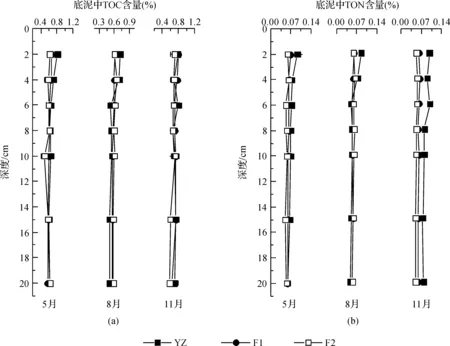
图5 2013年5月、8月和11月养殖区(YZ)、50 m区(F1)和100 m区(F2)沉积物中总有机碳(a)和总有机氮(b)含量Fig.5 Values of total organic carbon (a) and total organic nitrogen (b) in sediments for the fish farm (FZ), the stations 50 maway (Y1) and 100 m away (Y2) in May 2013, Aug. 2013 and Nov. 2013误差棒为标准差(n=3)Error bars indicate standard deviations (n=3)
YZ区沉积物中TP(图4)、TON和TOC含量(图5)的变化范围分别为21.625~40.125 μmol/g、0.049%~0.097%和0.504%~0.814%,而F1区和F2区沉积物中相应有机质的含量分别为 19.200~25.083 μmol/g、0.051%~0.069%和0.493%~0.798%。水平分布上,YZ区沉积物中的TP 和 TON含量显著高于F1和F2区(P<0.05);YZ区表层沉积物(0~4 cm)中的TOC含量高于F2区,但是只有8月份时有显著性差异(P<0.05)。从季节性变化来看,YZ区表层沉积物(0~4 cm 层)中,TP含量8月最高,5月最低;TON和TOC含量由高到低依次为11月>5月>8月。沉积物中有机物(OM)的变化范围是1.55%~2.35%,平均为1.95%(表1)。除11月外,YZ区沉积物中有机物含量高于F1和F2区,5月时与F2区差异显著(P<0.05)。沉积物中硫化物的含量为0.17%~0.48%,各站位间差异不显著(P>0.05),说明F1和F2区与YZ区站位沉积物的氧化还原条件基本相似。

表1 养殖区(YZ)、50 m区(F1)和100 m区(F2)沉积物中有机物(OM)和硫化物(S)含量
2.2采样区海水水质参数


表2 养殖区(YZ)、50 m区(F1)和100 m区(F2)海水温度及水中溶解氧和营养盐质量浓度
2.3底泥耗氧率(SOCs)及营养盐通量
YZ区底泥耗氧率(SOCs)除5月外,均高于F1和F2区 (图6)。8月,YZ区SOCs与F1区差异显著(P<0.05),而11月则与F2区有显著性差异(P<0.05)。YZ区在8月耗氧量最高,5月最低。
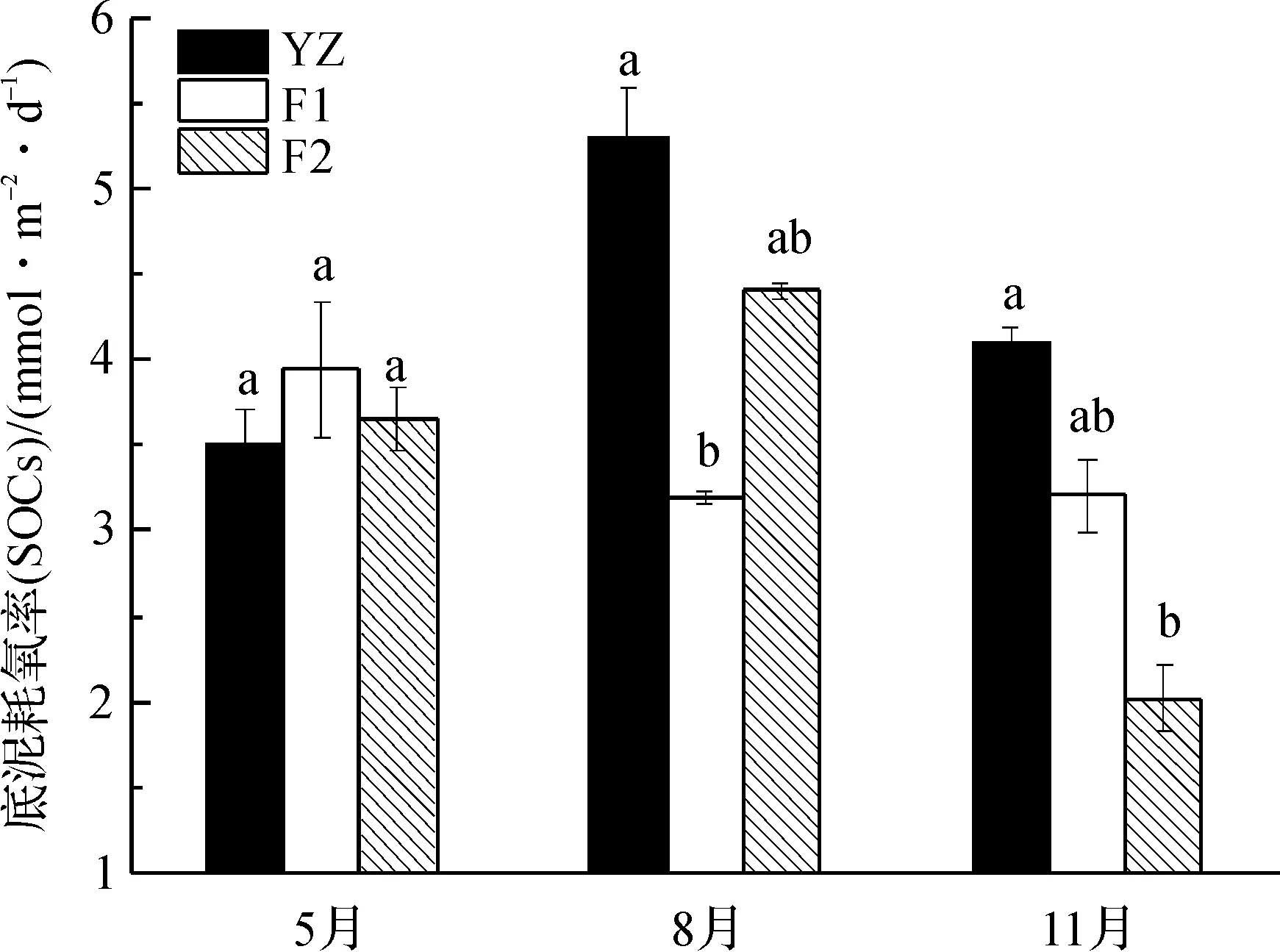
图6 2013年5月、8月和11月养殖区(YZ)、50 m区(F1)和100 m区(F2)底泥耗氧率(SOCs)Fig.6 Sediment oxygen consumption (SOCs) rates for thefish farm (YZ), the stations 50 m away (F1) and 100 maway (F2) in May 2013, Aug. 2013 and Nov. 2013误差棒表示标准差(n=3)。字母a和b表示不同地点差异显著,为同一字母则无显著性差异 (P<0.05)Error bars indicate standard deviations (n=3). Letters a and bindicate that there are notable differences in different sites, thesame letter means no notable differences (P<0.05)



3讨论
3.1底泥理化性质
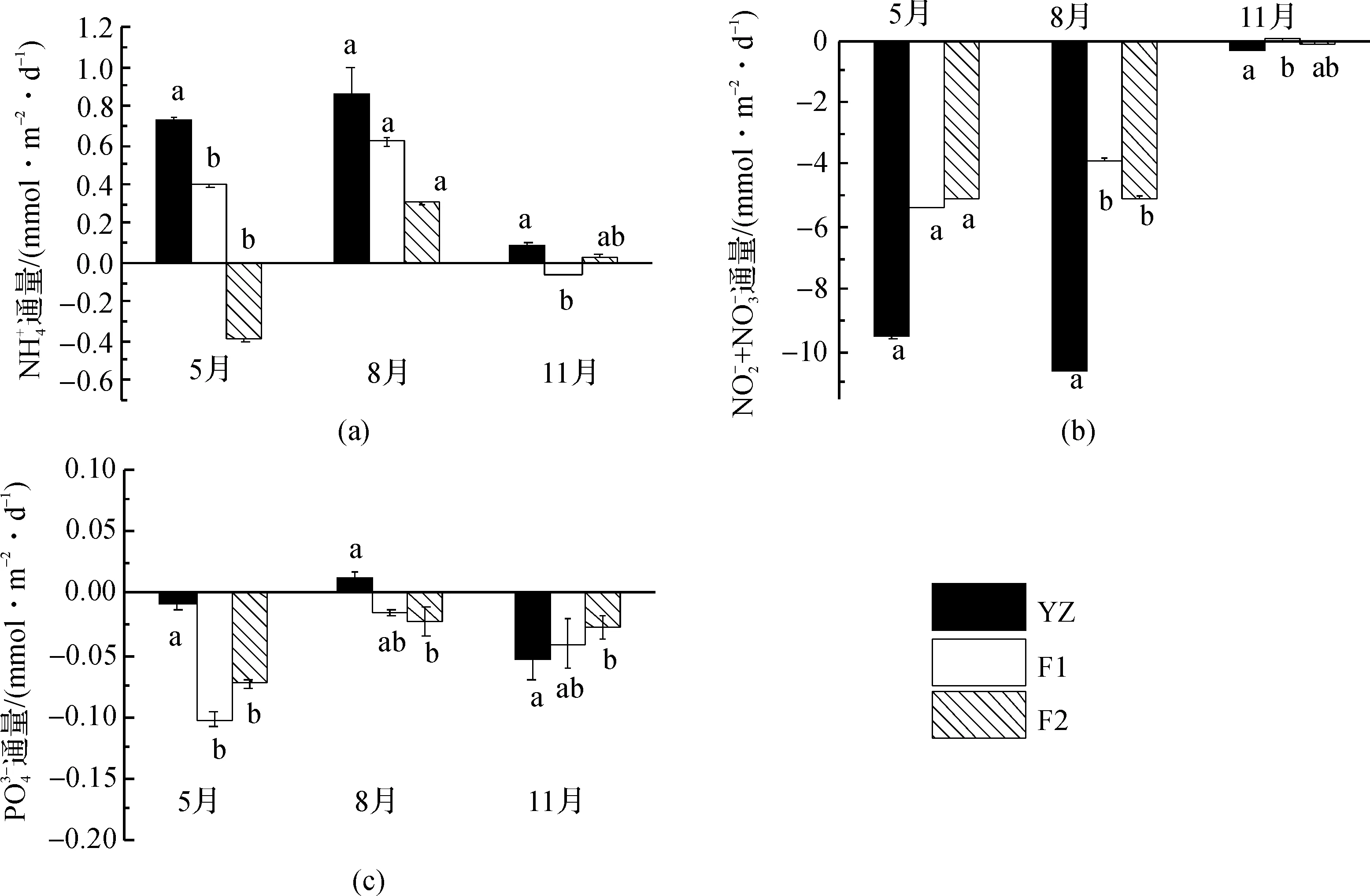
图7 2013年5月、8月和11月养殖区(YZ)、50 m区(F1)和100 m区(F2)沉积物-水界面和通量Fig.7 Benthic fluxes of (a), (b), (c) for the fish farm (YZ), the stations 50 m away (F1)and 100 m away (F2) in May 2013, Aug. 2013 and Nov. 2013
已有研究显示,养殖活动能导致沉积物的有机污染[11,15 ]。沉积层有机物的积累很可能引起水体富营养化[5],当底泥中有机物的含量达到9%时,甚至会降低底栖生物群落的多样性[17]。本研究中,YZ区表层沉积物中的TP和TON含量显著高于F1和F2区,表明大黄鱼养殖活动导致了沉积物中有机物的积累。养殖活动对沉积环境影响的大小及范围常因地点而异[10,18]。CRANFORD et al[18]和YOKOYAMA et al[8]研究指出养殖活动能影响周围300 m的区域。本实验中,养殖区周围区域(F1和F2区)沉积物中的TON(0.051%~0.069%)、TOC含量(0.493%~0.798%)与其他养殖区沉积物中的有机物含量差不多(表3),表现出了有机物富集的趋势,表明大黄鱼养殖活动对养殖区周围100 m区域的沉积物造成了有机污染。本研究区域沉积物中有机物含量显著低于菲律宾波里纳奥刺目鱼养殖区[7](表 3),这可能与养殖种类和养殖区域水文条件(本研究区为典型的半日潮)有关。研究发现,本研究区域沉积物中的TON和TOC含量与东海赤潮高发区表层沉积物中TON(0.047%~0.110%)和TOC(0.32%~0.82%)含量差不多[19],暗示大黄鱼养殖活动造成的有机污染可能会引起养殖水域水体富营养化。

表3 各养殖区表层沉积物中TON、TOC和TP含量比较
注:空白处表示无数据
3.2沉积物-水界面营养盐通量
沉积物中氧气的消耗过程由微生物介导的有机物氧化及营养盐的还原所驱使[24]。本研究中,养殖区的耗氧量表现为8月最大,除了受温度影响外,沉积层中有机物的供给速率及有机物含量的增加是底泥耗氧量增多的一个很重要的因素[25]。有机物堆积在沉积物中,促使分解有机物的微生物群落迅速增长,导致沉积层中的耗氧大大增加[26],这可能使底泥形成亚氧化层甚至形成无氧区域,最终影响底部营养盐的再生。本实验中YZ区的SOCs显著高于F1和F2区,在其他受养殖活动影响的区域也观察到了这种现象[11]。

表4 各养殖区沉积物-水界面营养盐通量比较
注:空白处表示无数据
本实验中各营养盐通量表现出明显的季节性变化,养殖区的通量在8月达到最值,可能是8月养殖活动强度较大,产生的残饵、粪便等有机物较多,促使微生物大量繁殖,加速了各种反应;8月温度较高,促进了离子的扩散,也是8月通量值达到最值的原因之一。
4小结

参考文献(References):
[1] BROOKS K M, MAHNKEN C V. Interactions of Atlantic salmon in the Pacific northwest environment: II Organic wastes [J]. Fisheries Research,2003,62(3):255-293.
[2] GRIGORAKIS K, RIGOS G. Aquaculture effects on environmental and public welfare-the case of Mediterranean mariculture [J]. Chemosphere,2011,85(6):899-919.
[3] KARAKASSIS I, TSAPAKIS M, HATZIYANNI E, et al. Impact of cage farming of fish on the seabed in three Mediterranean coastal areas [J]. ICES J Mar Sci: Journal du Conseil,2000,57(5):1 462-1 471.
[4] JIANG Zeng-jie, FANG Jian-guang, MAO Yu-ze, et al. Eutrophication assessment and bioremediation strategy in a marine fish cage culture area in Nansha Bay [J]. China Journal of Applied Phycology,2010,22(4):421-426.
[5] HUUSKONEN S E, RISTOLA T E, TUVIKENE A, et al. Comparison of two bioassays a fish liver cell line (PLHC-1) and a midge (Chironomusriparius), in monitoring freshwater sediments [J].Aquatic Toxicology,1998,44(1):47-67.
[6] HALLARE A V, SEILER T B, HOLLERT H. The versatile changing and advancing roles of fish in sediment toxicity assessment—a review [J]. Journal of Soils and Sediments,2011,11(1):141-173.
[7] HOLMER M, MARBA N, TERRADOS J, et al. Impacts of milkfish (Chanoschanos) aquaculture on carbon and nutrient fluxes in the Bolinao area Philippines [J]. Mar Pollut Bull,2002,44(7):685-696.
[8] YOKOYAMA H, ABO K, ISHIHI Y. Quantifying aquaculture-derived organic matter in the sediment in and around a coastal fish farm using stable carbon and nitrogen isotope ratios [J]. Aquaculture,2006,254(1):411-425.
[9] LAM K S, MACKAY D W, LAU T C, et al. Impact of marine fish farming on water quality and bottom sediment: a case study in the sub-tropical environment [J]. Marine Environmental Research,1994,38(2):115-145.
[10] MORATA T, SOSPEDRA J, FALCO S, et al. Exchange of nutrients and oxygen across the sediment-water interface below aSparusauratamarine fish farm in the north-western Mediterranean Sea [J]. Journal of Soils and Sediments,2012,12(10)1 623-1 632.
[11] CAI Hui-wen, SUN Ying-lan, ZHANG Xue-qing. Environmental impact of cage aquaculture and aquaculture environmental capacity in Xiangshan harbor [J]. Techniques and Equipment for Environmental Pollution Control,2006,7(11):71-76.
蔡惠文,孙英兰,张学庆.象山港网箱养殖对海域环境的影响及其养殖环境容量研究[J].环境污染治理技术与设备,2006,7(11):71-76.
[12] QIU Qiong-fen, ZHANG De-min, YE Xian-sen, et al. The bacterial community of coastal sediments influenced by cage culture in Xiangshan Bay, Zhejiang, China[J]. Acta Ecologica Sinica,2013,33(2):483-491.
裘琼芬,张德民,叶仙森,等.象山港网箱养殖对近海沉积物细菌群落的影响[J].生态学报,2013,33(2):483-491.
[13] WANG You-shao, XU Ji-rong. A borderless disturbed sediment core sampler: China, CN1683915A[P].2004-10-19.
王友绍,徐继荣.一种无边界扰动的单管沉积物采样器:中国,CN1683915A[P].2004-10-19.
[14] ZHENG Zhong-ming, DONG Shuang-lin, TIAN Xiang-lin, et al. Sediment-water fluxes of nutrients and dissolved organic carbon in extensive sea cucumber culture ponds [J].Clean-Soil, Air, Water,2009,37(3):218-224.
[15] MUDROCH A, AZCUE J M, MUDROCH P. Manual of physico-chemical analysis of aquatic sediments[M]. Florida,USA: CRC Press,1995:123-124.
[16] BOYLE J. A comparison of two methods for estimating the organic matter content of sediments [J]. Journal of Paleolimnology,2004,31(1):125-127.
[17] CHICILEV S, IVANOV M. Response of the Arctic benthic community to excessive amounts of nontoxic organic matter [J]. Mar Pollut Bull,1997,35(7):280-286.
[18] CRANFORD P J, HARGRAVE B T, DOUCETTE L I. Benthic organic enrichment from suspended mussel (Mytilus edulis) culture in Prince Edward Island Canada [J]. Aquaculture,2009,292(3):189-196.
[19] WANG Li-sha, SHI Xiao-yong, ZHANG Chuan-song. Distribution and origins of organic carbon and organic nitrogen in ECS sediments of high-frequency HABs areas[J]. Marine Environmental Science,2010,29(2):165-169.
王丽莎,石晓勇,张传松.东海赤潮高发区沉积物中有机碳,有机氮的分布及其来源[J].海洋环境科学,2010,29(2):165-169.
[20] ZHANG Xue-lei, ZHU Ming-yuan, TANG Ting-yao, et al. Fluxes of nutrients at sediment-water in Sanggou Bay and Jiaozhou Bay in summer [J]. Marine Environmental Science,2004,23(1):1-4.
张学雷,朱明远,汤庭耀,等.桑沟湾和胶州湾夏季的沉积物-水界面营养盐通量研究[J].海洋环境科学,2004,23(1):1-4.
[21] ZHAI Bing. Distribution characteristics, influential factors and pollution sssessment of nitrogen and phosphorus in surface sediments of Xiangshan Bay[D]. Qingdao: Ocean University of China,2006.
翟滨.象山港表层沉积物中氮和磷的分布特征,影响因素及其污染评价[D].青岛:中国海洋大学,2006.
[22] DE VITTOR C, FAGANELI J, EMILI A, et al. Benthic fluxes of oxygen, carbon and nutrients in the Marano and Grado Lagoon (northern Adriatic Sea Italy) [J]. Estuarine Coastal and Shelf Science,2012,113:57-70.
[23] MANTZAVRAKOS E, KORNAROS M, LYBERATOS G, et al. Impacts of a marine fish farm in Argolikos Gulf (Greece) on the water column and the sediment [J]. Desalination,2007,210:110-124.
[24] J J∅RGENSEN B B. Processes at the sediment-water interface[M]//BERT B, COOK R B. The major biogeochemical cycles and their interactions. SCOPE 21, Stockholm,1983:477-509.
[25] JENSEN M H, LOMSTEIN E, S∅RENSEN J. Benthic NH4and NO3flux following sedimentation of a spring phytoplankton bloom in Aarhus Bight Denmark Mar [J]. Ecol Prog Ser,1990,61:87-96.
[26] AXLER R, TIKKANEN C, MCDONALD M, et al. Water quality issues associated with aquaculture: A case study in mine pit lakes [J]. Water Environ Res,1996,68(6):995-1 011.
[28] SUN San, LI Jia-hui, JIN Yang, et al. Distribution features of nutrients and flux between the sediment and water interface in Sishili bay[J].Marine Environmental Sicence,2012,31(2):195-200.
孙珊,李佳蕙,靳洋,等.烟台四十里湾海域营养盐和沉积物-水界面交换通量[J].海洋环境科学,2012,31(2):195-200.
[29] CANFIELD D E, J∅GENSEN B B, FOSSING H, et al. Pathways of organic carbon oxidation in three continental margin sediments[J]. Marine Geology,1993,113(1-2):27-40.
[30] CLINE J D, RICHARDS F A. Oxygen deficient conditions and nitrate reduction in the eastern tropical North Pacific Ocean [J]. Limnol Oceanogr,1972,17(6):885-900.
[31] MURRAY J W, CODISPOTI L A, FRIEDERICH G E. Oxidation-reduction environments: the suboxic zone in the Black Sea [J]. ACS Advances in Chemistry Series,1995,244:157-176.
[32] BOON P I, MORIARTY D J W, SAFFIGNA P G. Rates of ammonium turnover and the role of amino-acid deamination in seagrass (Zosteracapricorni) beds of Moreton Bay Australia [J]. Marine Biology,1986,91(2):259-268.
[33] GARDNER W S, MCCARTHY M J, AN S. Nitrogen fixation and dissimilatory nitrate reduction to ammonium (DNRA) support nitrogen dynamics in Texas estuaries [J]. Limnology and Oceanography,2006,51(1):558-568.
Study on nutrient fluxes of sediment-water interface in cage culture zone of large yellow croakerPseudosciaenacroceain Xiangshan Bay
LIAO Hong-fang1,2,3, ZHENG Zhong-ming*1,3, REGAN Nicholaus1,3, ZHU Jin-yong1,3
(1.SchoolofMarineSciences,NingboUniversity,Ningbo315211,China;2.TheFirstMiddleSchoolofLinwu,Chenzhou424300,China; 3.CollaborativeInnovationCenterforZhejiangMarineHigh-efficiencyandHealthyAquaculture,Ningbo315211,China)
Abstract:Undisturbed sediment samples were collected from the cage culture zone and nearby of large yellow croaker’ farm in Xiangshan Bay in May, Aug. and Nov. of 2013. Total organic nitrogen (TON), total organic carbon (TOC) and total phosphorus (TP) in the sediments were determined. A simulated experiment was conducted to study the sediment oxygen consumption (SOCs) rates and ) fluxes between water column and sediments. TON and TP values of sediment in cage-zone(YZ) are generally significantly higher than those in stations of 50 m away (F1) and 100 m away (F2) (P<0.05). The sediments release to the overlying water where as they takes up and . Benthic fluxes show that intensive seasonal variations and the release of and reach peak values in August, which response to increased organic input due to the yellow croaker farming. The nutrient concentration in water changes with benthic nutrient fluxes among seasons. The results obtained in this study imply that the ongoing aquaculture activities have led to sediment organic pollution at certain extent and the polluted sediment could affect the benthic nutrient fluxes, which might cause the redistribution of nutrients in water column.
Key words:fish farming; yellow croaker; sediment; nutrient flux; Xiangshan Bay
Doi:10.3969/j.issn.1001-909X.2016.01.011
中图分类号:S967.3
文献标识码:A
文章编号:1001-909X(2016)01-0084-09
作者简介:廖红芳(1988-),女,湖南郴州市人,主要从事近海养殖水域生态方面的研究。E-mail:nicelhf@163.com*通讯作者:郑忠明(1965-),男,教授,主要从事水域生态学方面的研究。E-mail:zhengzhongming@nbu.edu.cn
基金项目:国家科技支撑计划项目资助(2011BAD13B08);国家星火计划项目资助(2013GA701020);宁波自然科学基金项目资助(2012A610168)
收稿日期:2014-11-05修回日期:2015-12-08
廖红芳,郑忠明,REGAN Nicholaus,等.象山港大黄鱼Pseudosciaenacrocea网箱养殖区沉积物-水界面营养盐通量研究[J].海洋学研究,2016,34(1):84-92,doi:10.3969/j.issn.1001-909X.2016.01.011.
LIAO Hong-fang, ZHENG Zhong-ming, REGAN Nicholaus, et al. Study on nutrient fluxes of sediment-water interface in cage culture zone of large yellow croakerPseudosciaenacroceain Xiangshan Bay[J]. Journal of Marine Sciences, 2016,34(1):84-92, doi:10.3969/j.issn.1001-909X.2016.01.011.
